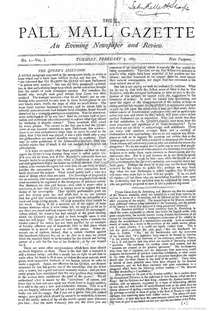The Pall Mall Gazette
 Front page of the first edition | |
| Type | Daily (afternoons) |
|---|---|
| Owner(s) |
G. Smith (1865–80) H. Thompson (1880–92) W. Astor (1892–1915) H. Dalziel (1916–23) |
| Founded | 7 February 1865 |
| Language | English |
| Ceased publication | 1923 |
| Headquarters | London |
The Pall Mall Gazette was an evening newspaper founded in London on 7 February 1865 by George Murray Smith; its first editor was Frederick Greenwood. In 1921, The Globe merged into The Pall Mall Gazette, which itself was absorbed into the Evening Standard in 1923.
History
The Pall Mall Gazette took the name of a fictional newspaper conceived by William Makepeace Thackeray. Pall Mall is a street in London where many gentlemen's clubs are located, hence Thackeray's description of this imaginary newspaper in his novel The History of Pendennis (1848–1850):
"We address ourselves to the higher circles of society: we care not to disown it—the Pall Mall Gazette is written by gentlemen for gentlemen; its conductors speak to the classes in which they live and were born. The field-preacher has his journal, the radical free-thinker has his journal: why should the Gentlemen of England be unrepresented in the Press?
Under the ownership of George Smith from 1865 to 1880, with Frederick Greenwood as editor, the Pall Mall Gazette was a Conservative newspaper. Greenwood resigned in 1880 when the paper's new owner wished the paper to support the policies of the Liberal Party.
William Thomas Stead's editorship from 1883 to 1889 saw the paper cover such subjects as child prostitution; their campaign helped get the government to increase the age of consent from 13 to 16 in 1885. This was one of the first examples of investigative journalism, and Stead was arrested for "unlawful taking of a child" (when he purchased thirteen-year-old Eliza Armstrong from her mother for the meager price of £5, to highlight how easy it was to buy children).
Henry Cust, editor from 1892 to 1896, returned the paper to its Conservative beginnings.
Several well-known writers contributed to The Pall Mall Gazette over the years. George Bernard Shaw gained his first job in journalism writing for the paper. Other contributors have included Anthony Trollope, Friedrich Engels, Oscar Wilde, Robert Louis Stevenson, Charles Whibley, Sir Spencer Walpole, Arthur Patchett Martin,[1] and Jamaican-born writer Eneas Sweetland Dallas.
References in popular culture
The Pall Mall Gazette is referred to in numerous other media works. For example:
- It is referred to in Dr Watson's Sherlock Holmes stories (in "The Adventure of the Blue Carbuncle" (1892)), as one of the newspapers Holmes sent an advertisement to.
- The Pall Mall Gazette is referred to in Bram Stoker's epistolary novel Dracula (1897); the reader is presented with an article describing the escape of a wolf from the Zoological Gardens.
- The Pall Mall Gazette is referred to in H. G. Wells' The Time Machine (1895); when the Time Traveller returns to London he sees that day's copy of the Pall Mall Gazette and knows he is back at his original starting point in time, as well as in his War of The Worlds (1898); when the narrator describes the "pre-Martian periodical called Punch" as a prophecy.
- The Pall Mall Gazette is referred to in Time After Time (1979 film) in which a fictionalized H. G. Wells, played by Malcolm McDowell, is a time traveler who finds himself 90 years in his future, chasing Jack the Ripper, played by David Warner (actor), through the city of San Francisco in the year 1979. While in a revolving restaurant, a new female friend, Amy (played by Mary Steenburgen), states that Wells strikes her as the type that, "Never reads a newspaper." Wells replies, "I used to write for a newspaper, the 'Pall Mall Gazette.'" Time After Time was the first feature film directed by Nicholas Meyer.
- In the Peruvian novel Vienen los Chilenos (The Chileans are Coming) written by Guillermo Thorndike, the narrator describes how a Mr Petrie, an English gentleman travelling to Lima, Peru, during the Saltpeter War in the 19th century, goes to the Phoenix Club located in that city. In this club, Englishmen and England-educated Peruvians meet and converse in English. The library is provided with American and British newspapers. Mr Petrie picks the Times, the Pall Mall Gazette', and some American newspapers, and reads several international news, including the attempt on the tsar's life, the famine in Ireland, the fighting between British and Afghan troops, and the cavalry attacks on the Sioux in the United States.
Ownership
- George Smith (1865–1880)
- Henry Yates Thompson (1880–1892)
- William Waldorf Astor (1892–1917)
- Henry Dalziel (1917–1923)[2]
Editorship
| Editor's name | Years |
|---|---|
| Frederick Greenwood | 1865–1880 |
| John Morley | 1880–1883 |
| William Thomas Stead | 1883–1889 |
| Edward Tyas Cook | 1890–1892 |
| Henry Cust | 1892–1896 |
| Douglas Straight[3] | 1896–1909 |
| Frederick Higginbottom | 1909–1912 |
| James Louis Garvin | 1912–1915 |
| D. M. Sutherland | 1915–1923 |
See also
References
Further reading
- John Scott (1950). The Story of the Pall Mall Gazette, of its first editor Frederick Greenwood and of its Founder George Murray Smith. Oxford University Press.
- Raymond Schultz (1972). Crusader in Babylon: WT Stead and the Pall Mall Gazette.
External links
| Wikimedia Commons has media related to Pall Mall Gazette. |
- Pall Mall Gazette
- The W.T. Stead Resource Site
- Turner, John (1993). Lundy, Darryl, ed. "Exhibit 127: (William Waldorf Astor)". The Peerage.